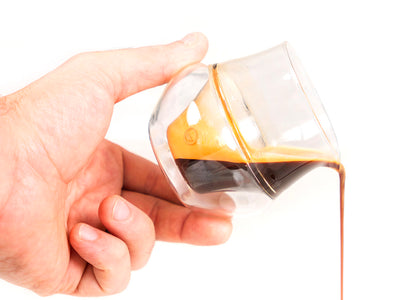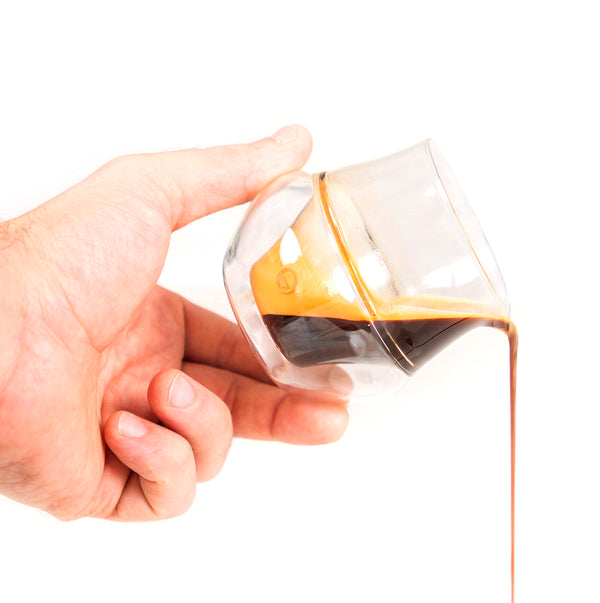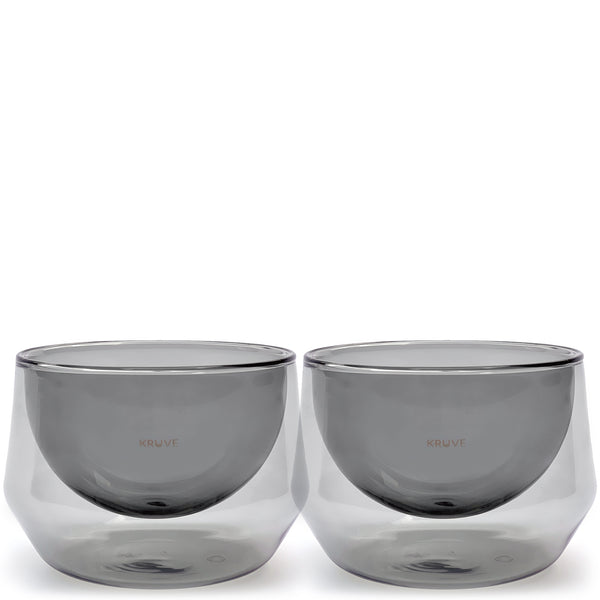SENSORY GUIDE
Please enjoy this sensory experience guide, which provides a fun and engaging way to show how KRUVE EQ glassware can harmonize your senses. It includes key flavor characteristics to look out for, along with a chart to plot your perception!

FINDING HARMONY
UNDERSTANDING A BIT OF SENSORY SCIENCE
How horrible is it when your favourite song comes on and the bass is weak or the treble is ear-piercing? Well-balanced audio requires the use of a good equalizer (EQ), and just like audio, great flavor requires harmony and balance. With this in mind, KRUVE used several science-backed sensation and perception principles to harmonize the senses:
TOUCH
Both glasses feature hand blown double-walled borosilicate glass to keep the coffee warm, yet cool to the touch; while the single wall keeps the rim thin, so that it’s comfortable to drink.
TASTE
Each glass differs in terms of liquid surface area, which affects the rate of oxidation, and in turn softens or amplifies tannins and acidity. They also differ in terms of rim architecture, which affects the flow and spread of coffee on your tongue.
SMELL
Each glass also features a different internal shape and amount of headspace, which can greatly impact the aromatic focus of the beverage.
SIGHT
The flavor profile is not the only place you’ll find balance. The glasses are a perfect inverse of each other on the outside, yet completely unique on the inside. Also, the clear glass material allows for true appreciation of texture and color.

EVALUATING COFFEE
FIVE KEY CHARACTERISTICS
Coffee can be evaluated in multiple ways and the Specialty Coffee Association (SCA) is the probably the foremost authority in this area, with a comprehensive list of resources, so we encourage you to explore their information. However, with the KRUVE EQ glassware, it is now possible to Harmonize Your Senses™ like never before.
So, we're aiming to provide a fun introductory sensory experience designed specifically with KRUVE EQ glassware in mind. Please have a look at the coffee characteristics below and consider how you would rate them on a scale from 1 to 5:
CHARACTERISTIC
DESCRIPTION
RATING
COLOR
Color can often signify whether a coffee is under or over-extracted.
5 = Rich vibrant colors and a clear even liquid;
1 = Dull muted coloration and opaque or muddy liquid.
AROMA
Evaluated equally for its intensity and quality.
5 = Pleasant intense smell such as fruity, floral, or nutty.
1 = Weak and unpleasant smell.
SWEETNESS
Discernable, but not overbearing. May include subtle tart and/or bitter notes.
5 = Bright and clearly distinct (think ripe fruit or brown sugar);
1 = Lacking sweetness or overbearing bitter/sour notes.
ACIDITY
A crisp, even stinging feeling on the tongue, similar to the taste you get when biting into a citrus fruit.
5 = Sharp juicy taste that livens up the coffee;
1 = Flat and dull in texture, does not activate the tongue.
AFTERTASTE
The flavor notes that remain and reveal themselves after swallowing the coffee.
5 = Taste lingers and even develops/improves over time;
1 = Taste is short-lived and/or worsens over time.
EXPERIMENT. ENJOY.
CHARTING YOUR EXPERIENCE
Evaluating coffee takes practice! Fortunately, comparing and contrasting flavor using different glasses is extremely helpful when developing your palette. The interactive Flavor Profile chart below works with any/all glassware, but it especially helps to convey the difference a glass can make.
While finding harmony and balance is often ideal, don’t forget - you are ultimately in control! As with audio equalization, some may prefer more bass while others prefer more treble. KRUVE EQ glassware similarly allows you to dial up or dial down key flavor characteristics and help determine the right profile for you.
PRO TIP: Be sure to let your coffee cool slightly, so it’s more comfortable to drink and flavors are more pronounced.
STEP 1
Pour equal amounts of coffee into the EXCITE and INSPIRE glass (approx. 5oz each).
STEP 2
For each glass, evaluate the flavor characteristics and plot them on the Flavor Profile chart below.
STEP 3
Based on the results of your flavor profile, you can now adjust your brewing or drinking vessel to suit your preference!
FLAVOR PROFILE
INTERACTIVE GRAPH

PROPEL Server - Daddy Got Coffee Edition

OutIn x KRUVE Barista Set

PROPEL Server - Daddy Got Coffee Edition

OutIn x KRUVE Barista Set


